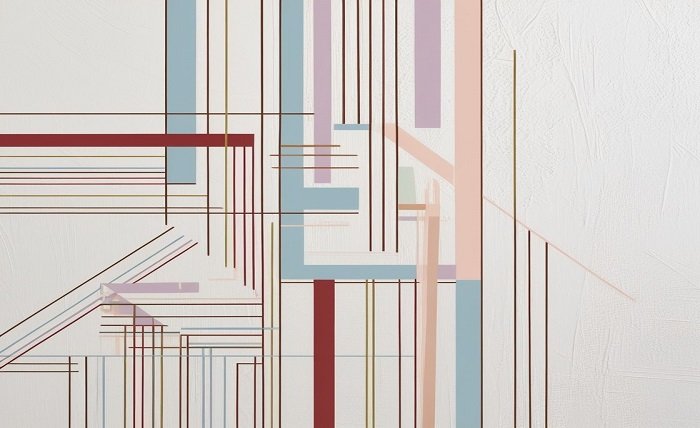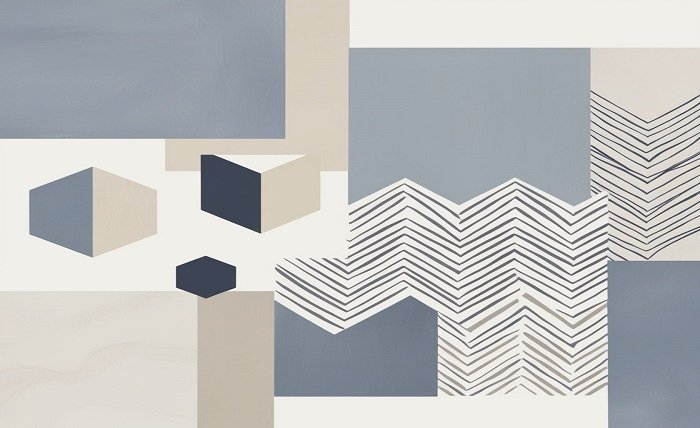For generations, simple geometric patterns have enthralled artists, designers, and common people. Their repeating, organized patterns are a popular choice in many industries, including fashion and architecture, since they can inspire a sense of harmony and order. We’ll explore basic simple geometric patterns in this blog article, looking at their uses, importance, and how you might apply them to your own artistic endeavors.
Comprehending Geometric Patterns
Geometric Patterns: What Are They?
Shapes like squares, triangles, circles, and polygons are the building blocks of simple geometric patterns, which are organized repeatedly or methodically. These patterns can be seen in artwork, man-made buildings, and the natural world. Geometric patterns are simple because they are based on basic shapes that are easily manipulable to produce visually pleasing designs.
The Background of Geometric Designs
The history of simple geometric patterns extends back to the time of ancient civilizations. The Greeks employed simple geometric patterns in their mosaics and pottery, while the Egyptians used them in their textiles and architecture. Islamic art is well known for its elaborate simple geometric patterns, which frequently eschew the depiction of actual animals in favor of abstract forms. The perception of basic geometric patterns today gains depth from its historical relevance.
The Appeal of Simplicity
Why Opt for Basic Patterns?
Viewers frequently respond more deeply to simplicity. Basic geometric designs are adaptable for a variety of uses because they have a clear, uncomplicated look. They can be used in design as backdrops, accents, or even focal points. This basic technique can be easily incorporated into both classic and modern styles.
Impact of Geometric Patterns on the Mind
Geometric patterns have the power to elicit feelings. These designs’ systematic style might evoke sentiments of stability and serenity. On the other hand, disorganized setups could cause stress or enthusiasm. Knowing these psychological consequences can assist you in selecting designs that will best fit the intended emotional tone for your projects.
Uses for Basic Geometric Patterns
Interior Style
Simple geometric patterns have a transformational power in interior design. These patterns can provide subtle depth and intrigue to a space without overpowering it, whether they are used in furniture, carpets, or wallpaper. Popular options with distinct personalities include polka dots, herringbone, and chevron.
Textiles and Fashion
Fashion designers frequently incorporate geometric motifs into clothing and accessories. A garment’s visual appeal can be enhanced by a range of designs, such as delicate fabrics and strong prints. Basic geometric patterns work especially well for making bold statements or giving minimalist clothing more depth.
Visual Design
Simple geometric patterns can produce visually stunning images in graphic design. To project a contemporary and polished appearance, they are frequently utilized in branding, websites, and promotional materials. Creative and striking designs can result from combining geometric elements with negative space.
Visual Arts and Illustration
Simple geometric patterns have long been used in artwork by illustrators and artists. There are countless creative options when it comes to combining and manipulating basic forms to create complex designs. These patterns can be used as backdrops or focal points, giving the artwork structure and interest.

Making Your Own Easy Geometric Designs
Required Equipment and Supplies
Simple geometric designs can be made without expensive instruments or sophisticated knowledge. To get started, simple supplies like paper, pencils, and rulers may be sufficient. Geometric pattern generation for digital graphics can be aided by free apps like Canva or products like Adobe Illustrator.
A Comprehensive Guide to Creating Patterns
- Select Your Forms: Select the geometric shapes that you wish to utilize. Squares, triangles, and circles provide great beginning points.
- Create a Grid: In your design software, set up guides or use a ruler to construct a grid on paper. Your patterns will remain consistent with the aid of this grid.
- Start Arranging: Drag and drop the shapes you’ve selected onto the grid. Try out various arrangements, angles, and dimensions.
- Include Color: After the arrangement is to your liking, think about incorporating some color. A limited color scheme might improve your pattern’s efficacy and simplicity.
- Refine and Repeat: Modify your design as necessary. A final result that is polished and coherent can be achieved by repeating the process.
Source of Inspiration for Basic Geometric Designs
Nature
Simple geometric patterns can be inspired by many things in nature. Take note of how leaves and flowers are arranged, as well as the geometric patterns in snowflakes. You might get inspiration for your own creations by studying nature.
Buildings
Simple geometric patterns are frequently found in architectural constructions, ranging from historic buildings to contemporary skyscrapers. Look through architectural periodicals or take a tour around your city to get ideas from the forms and lines of structures.
Commonplace Items
Moreover, commonplace objects might serve as design inspiration. Think about the designs on fabrics, tiles, and packaging. Examining these items can result in original interpretations of basic geometric designs.
Summary
Simple geometric patterns have roots in psychology, history, and practicality in addition to being visually beautiful designs. Because of their adaptability, they can be used in a variety of fields, including fashion, art, and interior design. You can use the elegance and simplicity of these patterns in your projects by comprehending the underlying ideas and experimenting with your own designs.
FAQs pertaining to basic geometric patterns
1. Which geometric shapes are most frequently utilized in patterns?
The most popular shapes are hexagons, squares, triangles, and circles. Numerous combinations of these forms can be made to produce original patterns.
2. How can I use geometric patterns in the interior design of my house?
Simple geometric patterns can be used in artwork, rugs, throw pillows, and wallpaper. Gradually add larger pieces by starting with smaller accents.
3. Are geometric patterns appropriate for every type of design?
Yes, geometric patterns go well with both modern and rustic design elements. Making decisions about colors and shapes that complement the overall look is crucial.
4. Is it possible to digitally make geometric patterns?
Of course! Numerous graphic design software packages, like Canva and Adobe Illustrator, provide tools designed especially for making geometric patterns.
5. When it comes to geometric designs, what color scheme works best?
If simplicity is to be maintained, a limited color palette usually works best. However, depending on your design objectives, strong colors might produce a remarkable effect.
6. How can I find out more about designing patterns with geometry?
Think about enrolling in online courses or seeing YouTube lessons. Don’t be afraid to experiment with new forms and configurations because practice makes perfect.
Read more about: on cloud shoes

